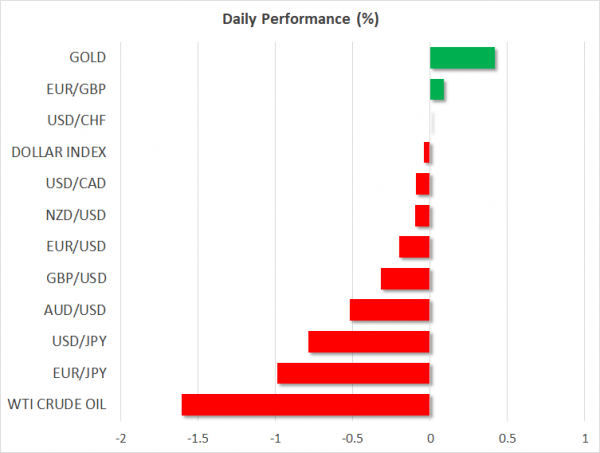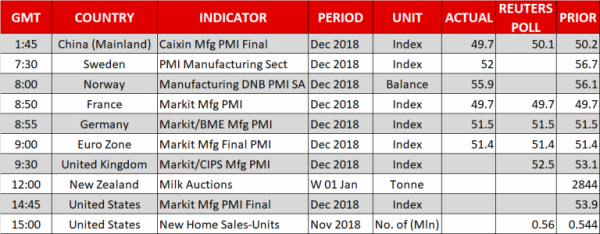- Chinese factory activity contracts, feeding growth slowdown fears
- Yen rallies to seven-month highs, aussie drops to three-year lows
- Oil extends downtrend into 2019
Stocks have a rough start as Chinese data disappoint
Stock markets in Asia started in the red in the first trading day of the year as lower than expected factory data out of the world’s second largest economy added further evidence of a potential slowdown in global growth.
The Chinese Caixin manufacturing index crossed unexpectedly below 50 in December for the first time in 19 months, hinting that the sector is contracting. The news pushed Shanghai’s CSI 300 stock index down by 1.40%, while Hong Kong’s Hang Seng stock index lost nearly 3.0%, with futures tracking US indices such as the S&P 500 pointing to another bear session as well later in the day. Japanese markets will be closed on Wednesday.
With business conditions in China deteriorating and clarity missing over how Washington and Beijing will finally solve their trade dispute, despite both sides showing willingness to do so, some additional stimulus might be needed later in the year to prevent further economic weakness. This may include an of easing monetary policy by the People’s Bank of China and more fiscal expansion by the government. Moreover, given the headwinds the rest of the world could face because of the trade war that seems to have started to bite, other key economies could also begin to ease policy, making it more difficult for the Fed to continue raising rates.
Safe-havens take the front seat
In FX markets, the dollar was on the back foot against its major counterparts after a positive yearly performance in 2017, amid increased speculation that the Fed may have potentially overestimated the number of rate hikes it plans to deliver in 2019 and therefore a more cautious period may be approaching ahead.
The Japanese yen was the best performer, jumping by 0.53% against the greenback to touch seven-month highs, while the aussie, whose fortunes are significantly tied to the Chinese economy, broke strong support around 0.70 to fall to near three-year lows. The sliding dollar could not help the euro and the pound either as the political environment remains fragile in Europe, with Brexit topping concerns. Should the British Parliament vote against May’s exit plan later this month, forcing a hard Brexit to take place in March, chances for a rate hike by the Bank of England and the European Central Bank may move well into the horizon.
Oil opens with losses
Crude prices registered their first yearly loss in three years and continued to decline at the start of the new year as traders were afraid that a downturn in China could squeeze demand for oil at a time when supply is in a big surplus. WTI crude and London’s based Brent tumbled by 1.80%, with sentiment depending largely on US production which is currently near all-time highs and the commitment between Russia and OPEC to cut supply and prop up prices. Developments around the US-Iran sanction story could also bring fresh volatility.

















